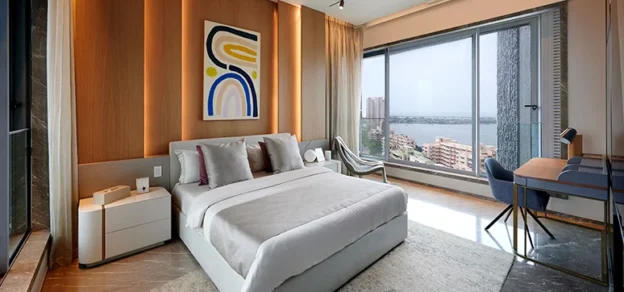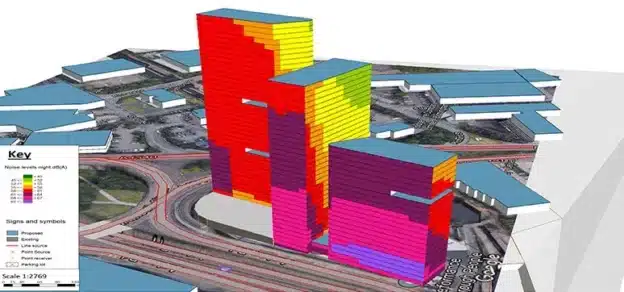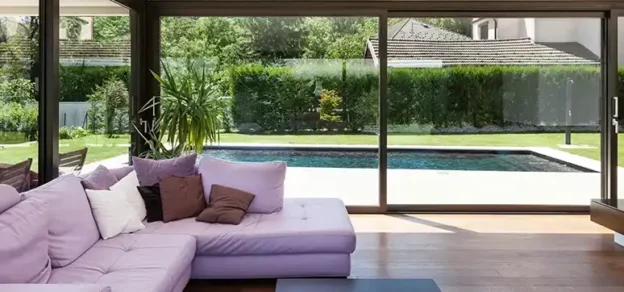Noise and noise pollution are typically affecting city populations. They rank among the most important environmental risks to health and continue to be a growing concern among policymakers and the public. As cited in World Health Organisation’s (WHO) environmental noise guidelines in 2018, traffic noise affects at least 100 million people in the European Union (EU), while in Western Europe alone at least 1.6 million healthy years of life are lost as a result of road traffic noise (EU Environmental Noise Directive). In the Emirate of Dubai, there were filed more than 2,500 noise complaints in 2019, mainly due to construction works in residential areas.
Large-scale surveys show that road traffic noise is the most important source of annoyance. This is followed closely by neighbour noise. Aircraft noise can also be a significant source of annoyance. Railway noise and industrial noise are mentioned less frequently. The European Commission (EC) estimates that the social cost of noise and air pollution is up to €1 trillion every year (EC, 2016a). Considering the above, it is obvious that noise pollution does have a negative effect on humans. As per the World Health Organisation (WHO), noise effects on humans can have either critical health outcomes or important health outcomes. These can be linked to cardiovascular disease, hearing impairment, cognitive impairment, adverse birth outcomes, and metabolic outcomes.
Façade Design Contribution to Acoustic Comfort
A building envelope typically comprises different types of building elements that offer varying noise reduction. Façade glazing offers lesser sound reduction when compared to more robust constructions such as masonry. A good façade acoustic design can identify and address the acoustical problems, form a paradigm for a similar type of design scenarios within the building and for other buildings, meet the acoustic noise intrusion criteria for the building interior, offer a comfortable and productive indoor acoustic climate that leads to increased revenue, quiet conditions for concentration and studying, appropriate climate for teaching, better collaboration and good reputation, and demonstrate compliance of the project key performance indices.

Main Acoustic Performance Parameters to be Addressed in Façade Design
It is important to establish and clearly define the indoor noise targets that need to be achieved as per code/legislation, operator specifications, or project stakeholders. Moreover, define if the acoustic insulation descriptors are related to field or laboratory values. The external noise needs to be controlled by the façade glazing so that there is compliance achieved, and therefore a suitable acoustic comfort within the building interior. The correct glazing configuration is highly important: single or multiple layers of glazing, the right order of glass panes – from outside to inside, an appropriate air gap between glass panes, laminated glazing, etc.
When selecting the glass performance it is likely that strictly the laboratory value sound insulation rating will not suffice i.e. Rw or STC. Therefore, careful consideration needs to be given to the characteristic/frequency of the generating outdoor noise source e.g. low frequency from a neighboring HVAC rooftop plant. As such the Rw+Ctr or the OITC acoustic descriptors are recommended to be crosschecked. These acoustic descriptors are typically lower in value when compared to equivalent laboratory values. Resonance in the glazing configuration is also a critical factor when selecting the correct glass build-up.
The façade framing is a weak point and therefore needs to be accounted for in the design. Architectural/structural details such as mullions/transoms and other junctions are very critical in terms of their acoustical design. Their importance relates to enhancing flanking transmission control, meeting field performance, and maintaining proprietary installation. In addition, careful consideration for any operable openings, their closing and sealing mechanism, selection of suitable building materials, consideration of sound-absorbing façade surfaces, consideration of wind-induced aerodynamic noise during the design, consideration of façade shape in terms of noise during the design, location and treatments of ventilation openings and cladding typologies are additional factors that require attention.
All of the aforementioned factors would need to be in line with other multidisciplinary design disciplines such as structures, fire and life safety, thermal comfort, etc. And of course, the final solution would need to align with the client’s requirements, expectations, and needs.
Main Acoustic Issues Found in Buildings and Their Preventions
It is observed in many cases that acoustic design has not been considered during the building façade design, even when developments are located close to major noise sources such as highways, stadiums, airports, entertainment amenities, etc. Examples of poor design that results in offending sounds and consequently in unwanted indoor acoustic conditions are referenced below:
• Unsuitable glazing selection
• Unsuitable frame selection and installation
• Poor quality of materials and façade workmanship
• Inappropriate structural and architectural details such as transom configurations
• Untreated ventilation openings • Inappropriate junction details to the building interior
• Rigid connections between the building’s interior that don’t account for expansion and contraction e.g. a floating floor or a suspended ceiling rigidly connected to the façade

Retrofitting acoustic works to an existing façade can be a very challenging and complex solution that will have financial implications for the client.
The optimal approach would be to engage a qualified acoustical consultant at the project outset, who is able to carry out an appropriate assessment.
This involves examining the category for the development’s location in terms of noise exposure and relates to the planning authorities.
Following that, once the project design will start, a baseline environmental noise survey and/or predictive tools can be used to quantify the incident sound energy on the building location and its massing.
The assessment outcome can be used to inform other project stakeholders about the plot of land, building orientation, positioning of noise-sensitive spaces within the development, glazing, and frame build-up, and elements that assist in blocking or reducing the incident noise on the façade.
Regulations to Follow to Establish the Acoustic Performance of Façades

When designing a façade in Dubai there are a number of regulations that an acoustical consultant needs to follow. Since December 2021, the new Dubai Building Code (DBC) is in place, replacing the previous Green Building Regulations and Specifications (GBR&S). It aims to unify building design across Dubai and to create a building code that is easy to use. It applies to all new buildings and changes to existing buildings are described in Table A.1 (Figure 1), ppA9 of the document.
Moreover, it applies to the following occupancies, as referenced in Table A.2 (Figure 2), ppA9. A descriptive reference/performance statement is made to the acoustical performance of the building envelope. Reference is made to the site planning requirements, to the necessary guidance of an acoustic consultant for the project design and involvement, and references to additional standards in terms of the already used standards – Table H.17 (Figure 3), pp H85.

The new inclusions complement the acoustic design of each type of building and introduce the facility guidelines institute for healthcare buildings Dubai Health Authority Health facility guidelines. Reference is made to building services noise as per American Standards. The façade design aim is to meet the H.17 Table (Figure 3) or better.
The reference for noise intrusion relates to British Standards. These can relate to BS8233, Health Technical Memorandum 08 – 01, Building Bulletin 93, and British Council for Office, Guide to Specification. Finally, there can be hospitality or hospital operator specifications that need to be followed during the design and execution of a project. When such cases arise, it is important at first to offer compliance against the codes.














